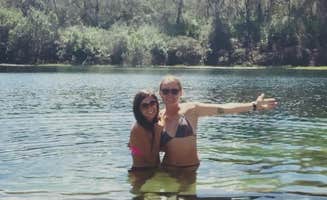Dispersed camping options in Ocala National Forest offer rustic camping near Sanford, Florida amid pine flatwoods and subtropical forest terrain. These primitive sites provide opportunities for solitude across the forest's 387,000 acres of diverse ecosystems. Weather conditions include hot, humid summers with frequent afternoon thunderstorms and mild winters, making seasonal preparedness essential for campers.
What to do
Kayak launching: Freak Creek Dispersed Camping provides direct water access for paddlers. "It's super secluded and quiet. Great place to put a kayak in the water," notes camper Adamm A.
Nighttime stargazing: Clear night skies offer excellent astronomical viewing opportunities away from light pollution. Pack red-filtered headlamps to preserve night vision.
Swimming in natural waters: Several sites offer swimming access, though conditions vary seasonally. At Trout Lake Primitive Sites, campers can enjoy the lake when water levels permit. "The setting is breathtaking," writes Laurence A. about the lake environment.
What campers like
Seclusion from crowds: Many dispersed sites provide genuine isolation. "It's super secluded and quiet. Depending when you stay there's at times people who show up to party and then leave," reports a visitor to Freak Creek Dispersed Camping.
Natural surroundings: Forest camping puts visitors directly in Florida's unique ecosystem. One camper at Trout Lake Primitive Sites described the experience: "It was soothing, and decided if I had to I could spend the night in car. It rained all night and morning."
Cost-effective camping: Most dispersed sites in the national forest are free or low-cost. "Most beautiful place to stumble upon," writes Destiny R. about the free primitive camping at Blue Sink.
What you should know
Vehicle requirements: Many sites require high-clearance vehicles or specific driving skills. "Not the cleanest but passable," reports a camper at Trout Lake Primitive Sites about the access roads. "Main road entry is packed dirt; smaller access road to sites is two-track about 1/4 mile through woods — very narrow tree clearance."
Limited facilities: No amenities means complete self-sufficiency. Bring adequate drinking water, portable toilet facilities, and food storage containers for these primitive sites.
Variable cell reception: Communication can be unreliable. One camper at Trout Lake Primitive Sites noted "Poor cell service even with booster. Plan on returning after antenna upgrade."
Safety considerations: Research specific sites before visiting. Some areas have reported safety concerns that require caution and awareness.
Tips for camping with families
Wildlife awareness: Teach children proper wildlife safety. One camper at Trout Lake Primitive Sites recalled, "I had a black bear sighting that afternoon and I had no bear spray."
Accessibility planning: Some sites require significant hiking or difficult vehicle access that may not suit young children. "The Forestry Service recently chopped down trees and covered the easy access roads," notes a visitor to Blue Sink.
Water safety protocols: Establish clear boundaries around water features. Lakes and creeks require supervision for children, especially at sites like St. Johns River Dispersed Spot where campsites are "Right next to the river."
Tips from RVers
Vehicle clearance concerns: Narrow forest roads present challenges for larger vehicles. "Very narrow trails but really easy access, you will leave with some new pinstripes," warns Joe P. about Trout Lake Primitive Sites.
Ground conditions: Sand and seasonal flooding affect accessibility. "I started panicking and trying to find a turn around after going through a very soft sandy spot," recounts a camper who brought a sedan to a site better suited for off-road vehicles.
Size limitations: Smaller trailers or truck campers work better than full-sized RVs. At Freak Creek, one camper advises, "I would not attempt bringing a camper unless it's really small."



